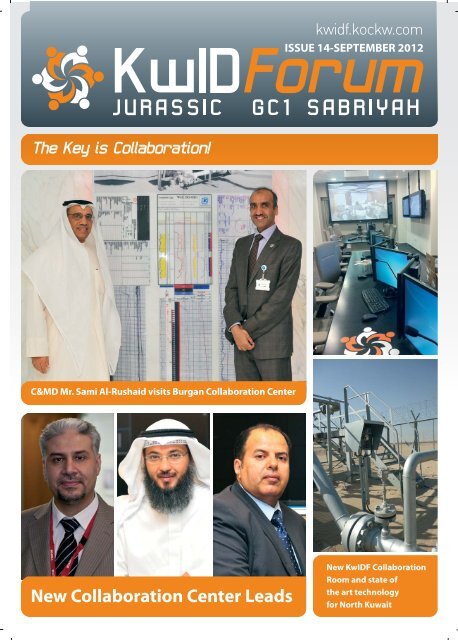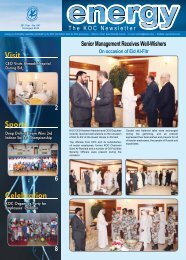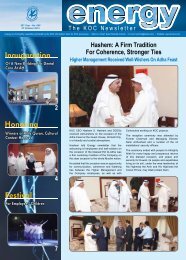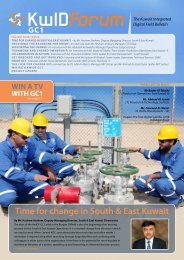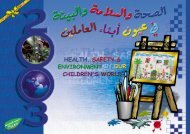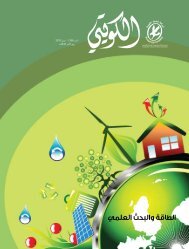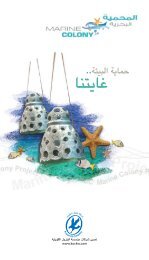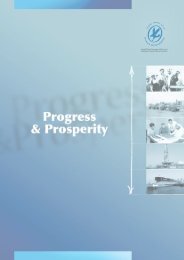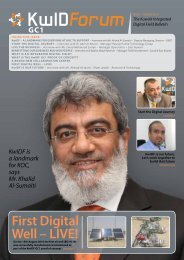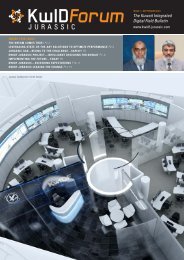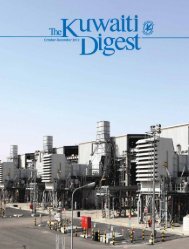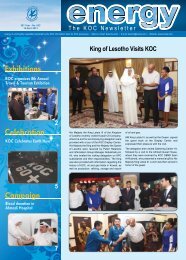Download The Kuwait Integrated Digital Field Bulletin Nº14 - KwIDF
Download The Kuwait Integrated Digital Field Bulletin Nº14 - KwIDF
Download The Kuwait Integrated Digital Field Bulletin Nº14 - KwIDF
You also want an ePaper? Increase the reach of your titles
YUMPU automatically turns print PDFs into web optimized ePapers that Google loves.
ISSUE 14-SEPTEMBER 2012<strong>The</strong> Key is Collaboration!C&MD Mr. Sami Al-Rushaid visits Burgan Collaboration CenterNew Collaboration Center LeadsNew <strong>KwIDF</strong> CollaborationRoom and state ofthe art technologyfor North <strong>Kuwait</strong>
West <strong>Kuwait</strong>:4th <strong>KwIDF</strong> project kicks offR&T proudly announces the kick-off of the 4th <strong>KwIDF</strong> project,located in West <strong>Kuwait</strong>, focused on the West <strong>Kuwait</strong> MinagishOolite Reservoir. <strong>The</strong> goal is to optimize production and waterinjection, so that the asset can achieve maximum recoveryfrom the reservoir.<strong>The</strong> project started with a conceptual study that concludedon May 23rd and reached an important milestone: the siteassessment of the “As-Is” phase. <strong>The</strong> project then continuedwith the “To Be” phase, which was again delivered under theformat of a workshop with the KOC leaders and project teams.It covered the full understanding of the surface, sub-surface,IT & connectivity, and change management aspects that arekey to develop the next phase of the project. <strong>The</strong>se studiesare being developed by the KOC team of stakeholders anda Baker Hughes led consortium of companies.Interview with Hassan Abdul Rahim,Section Head PSGHow has the introduction of the Collaboration Centrebenefitted you in the field?Having real time data has enabled us to be able to seeinstantly what is happening in the field and is allowingus to respond quicker and more effectively to changingcircumstances as they happen. For example, theautomated chokes have allowed us to close wells remotelyand have significantly reduced the time to shut downthe field in cases of emergency.What do you see as the next steps on the collaborationjourney?Working with our colleagues in FDG we now have thetechnology platform to monitor , analyse and operateeach well in order to optimise the volume and ensurethe long term well health. Working together, this meansdeveloping our ways of working and operatingphilosophy and defining how we progress towardsachieving the collective Gas Strategy goals.Images of the first workshop delivered for <strong>KwIDF</strong> West <strong>Kuwait</strong>.One of the many technical session held between R&T (Sponsor of <strong>KwIDF</strong>) andthe WK key stakeholders.PAGE 2<strong>Kuwait</strong> Oil Company
CORPORATECollaboration“Our expectations aim very high”Mr. Hussain Al-Ajmi, North <strong>Kuwait</strong> Collaboration Center LeadMr. Hussain Al-Ajmi, Team Leader <strong>Field</strong>sDevelopment (SA/BA) has been appointedas the North <strong>Kuwait</strong> Collaboration CenterLeader. Even though this is a greatchallenge, Mr. Al-Ajmi recognizes theenormous opportunity that the projectrepresents, and is very eager to take <strong>KwIDF</strong>Sabriyah to a successful operational phase.What do you expect from <strong>KwIDF</strong>?Our dreams and expectations aim veryhigh. <strong>KwIDF</strong> is, without any doubt, thefuture of KOC, and we expect it to allow usthe optimization that our 2030 Strategysets as a goal, but also managing ourreservoirs in a sustainable way.Please mention specific objectives ortargets you want to achieve in yourCollaboration Center.We want to achieve a new way of working(Collaboration) that will bring the resultswe need and want. We are clear about thefact that <strong>KwIDF</strong> is not only aboutoptimization, but about bringing a changeto KOC that will allow us to stay competitive,increase our recovery factor, optimize ourproduction, and extend the life of ourreservoirs.What is the biggest challenge you arefacing and how do you plan to addressit?We think our greatest challenge at thismoment is to get everybody’s buy in,because in order to deliver results, everydecision taken in the Collaboration Centershould be respected and followed through.We also have full support from ourManagement and from Halliburton, but inorder to make this work, everybody has tobe in the same page and collaborating.What is your vision of a fully functionalCollaboration Center?Our vision is that of all the teams (FD, WSPO, IT) working together, taking decisionsin a collaborative manner. But let us notforget that this is still a pilot, in which weare all finding new solutions together. If wesucceed in optimizing production in acollaborative manner, there will be nodoubt that Collaboration will become ournew way of working.“HSE, including security, has been a big winner”Mr. Qasem Dashti - <strong>KwIDF</strong> Jurassic Collaboration Center LeadWhat was your vision for a CollaborationEnvironment?I believed the implementation of theenvironment would encourage broaderways of working. <strong>The</strong> accessibility of data,processes and tools would enhance ourteamwork.What contributions did you expect from<strong>KwIDF</strong> towards your vision?I wanted to achieve all the four layers ofthe pyramid of transformation (see below)i.e. instrumentation to data to interventions,real time, towards the goal of fieldoptimisation.What objectives did you want to achievewith a Collaboration Center?Production targets, a safety culture anda more integrated environment toprovide opportunities forsurface and sub surfacecommunities to contribute.In this way we would beable to betterintegrateelements of ourStrategic plan.Optimize/Improve the way we operateImprove Collaboration (<strong>Field</strong>s Development& Operations & Drilling)Achieve Efficient Reservoir Management& <strong>Field</strong> Development PlanningAdd automatic event detection (and define responsesystems)Integrate between monitoring, analysis, and actionReal time field awareness (safety and production)Data acquisition, validation, and analysis (i.e. Well Performance Analysis)Production Loss Reporting and AllocationInstall software tools to manage, visualize and analyze the data tomove from “data collection” to “Information Management”Achieve HSE objectivesInstall the right infrastructure and well instrumentation to collect sufficient datain real time or near real time.Obtain real time data to improve day to day well managementSurveillance Visualization and Alarming.How far have those expectations beenmet?Many expectations have been met, andmany items, including the developmentof 22 workflows have been achieved. <strong>The</strong>operations dashboard is utilized at alltimes. HSE, including Security, has beena big winner.What are the next steps towards yourvision?To build on our past successes, sustainingthe current technical solution, developingadvanced workflows, building inmaintenance of equipment and planningfor systems enhancement, and gettingour people and behaviors fully alignedwith the solution.PAGE 4<strong>Kuwait</strong> Oil Company
JURASSICA very successful three day workshop wasconducted with a senior Management KOCdelegation and top management ofSchlumberger Information Solutions (SIS).<strong>The</strong> aim for the KOC delegation was to lookat the latest offerings of technology by SISwhich could be applied to enhance thecurrently fully operational <strong>KwIDF</strong> Jurassicsystem and discuss all the elements of anenhancement roadmap. <strong>The</strong> highlight ofthe visit was a common understanding ofthe current state and a common approachtowards the goal of a fully utilizedintegrated collaborative system toefficiently manage the complex andchallenging reservoir and productionsystem. KOC delegates left immenselysatisfied with the quality of the discussions,the commitments of all parties and thealignment of the endeavour towards thefull realization of the vision.KOC leadership delegation visits SIS HQ inLondon and Technology Centre in AbingdonA delighted KOC – SLB Group in front of SIS HQ, London“<strong>The</strong> system allows the team to be really hands on”Interview with Les Hoftmeister (FDG)Les Hofmeister is a Consultant in the <strong>KwIDF</strong>Jurassic Collaboration Center, and a keyplayer when it comes to workingcollaboratively. He has been working in theCenter for the last few months, and nowelaborates on how <strong>KwIDF</strong> Jurassic and itssystems is changing their ways of working:“Qasem Dashti (Team Leader Gas <strong>Field</strong>Development Jurassic - West) and NouraAl Mai, (FDG Production Optimization UnitLead) have really been instrumental inguiding the systems integration”, says Le.“We now have a “state of the art” I-fieldsystem, with all the real time data you couldpossibly want from the field, “which helpsus make decisions faster, reduces‘downtime’ in the field and improves ouroverall resource managementeffectiveness.”It is also important to ensure employee’scapabilities support the use oftechnology. What has been the impactof <strong>KwIDF</strong> Jurassic on the team’sprofessional development?“Learning and development for the <strong>KwIDF</strong>Jurassic system is a continuous process andthe tools are the best possible to undertaketheir roles and learn from them. <strong>The</strong> systemallows the team to be really hands on. <strong>The</strong>yare able to pull up all the available data indetail and review with Senior Engineers todevelop their understanding and improvetheir ability to manage well production.UD’s are able to collaborate more easily toimplement testing or corrective measureswith PSG. <strong>The</strong>se activities are all a key partof the learning and development process.”What benefits have you seen in relationto your team’s objectives for productionoptimization?“<strong>The</strong> <strong>KwIDF</strong> Jurassic system enables us tohave a more balanced production profileacross the entire field. We are able to“visualize” the data which helps to “paint apicture” of what is going on, and zoom into data to understand where productionis coming from. It allows us to controlthings more easily, makes it easier toevaluate performance, enhances our abilityto conduct effective end to end reviews,implement the necessary change andidentify areas for future study.Its integration with Electronic Well IntegrityManagement System, (EWIMS) will allowfor a safer working environment for ourstaff and contractors.Realization of benefits will be anevolutionary process, using data alreadyin play to better inform decision makingon future requirements, as therequirements for asset managementchanges.”PAGE 6<strong>Kuwait</strong> Oil Company
SABRIYAHOpening of the <strong>Field</strong>Collaboration Room in NK<strong>The</strong> <strong>Field</strong> Collaboration Room is part of thecollaboration model proposed by <strong>KwIDF</strong>. Throughstate of the art technology, this room is connectedto the North <strong>Kuwait</strong> Collaboration in Ahmadi and,in this way, the asset is in the loop of collaborativedecision making. <strong>The</strong>y can also access all theworkflows and monitor the field in real time. In thepicture, Mr. Abdulla Al-Sumaiti, former ManagerProduction Operations NK (far right) visits the <strong>Field</strong>Room for the first time. With him, Mr. AdnanAl-Dashti, Actg. Actg. TL Production Operations,and Mr. Harish Goel, KwDIF Sabriyah ProjectManager.<strong>KwIDF</strong> Instrumentation Awareness CampaignAn Awareness campaign on <strong>KwIDF</strong>’s specialInstrumentation was delivered in the North<strong>Kuwait</strong> Asset to the Maintenance Team,Production Operations Team and differentcontractors. <strong>The</strong> aim of this campaign is tointroduce the new instrumentation beingput in place in the pilot wells and the openingof a hotline that will offer help andinformation in removing the instrumentsbefore a well work over. Some of the materialsincluded in this campaign are special signsthat will be posted on the well fences.If you see this sign, please call9901-6465. A maintenance team fromAlmeer on the <strong>KwIDF</strong> side will assist you inremoving our instrumentation, thus makingyour work easier.From left: Mr. Manish Kaptan (Mechanical Engineer, ABJ); Mr. Mohammed Al-Dhabiri (Mechanical Engineer, Maintenance NK); Mr. Adnan Dashti (Snr. PetroleumEng. PO NK); and Mr. Talal Al-Hasawi (Petroleum Eng. PO NK). Missing in thepicture: Mr. Jalwi Al-Mutairi (Section Head PO NK).Mr. S. Chandra Sekhar (TPL SpecialistI, Maintenance NK), and Mr. ShreifEmara (Project Eng. Kharafi National).Mr. Guillermo Velásquez, <strong>KwIDF</strong>Sabriyah Project Manager(Halliburton), delivering thepresentation.PAGE 8<strong>Kuwait</strong> Oil Company
Champions in the <strong>Field</strong>SABRIYAH<strong>The</strong> teams in North <strong>Kuwait</strong> are every time more involved in<strong>KwIDF</strong>, and their support is outstanding. All of them are happyto take part of the project as it is key in attaining their productiongoals: reduce production loss, reduce shutdown time bymonitoring the wells in real-time, and improving HSE issues,especially during the summer.<strong>KwIDF</strong> Sabriyah acknowledges their efforts and commitment.Together we will step into our brighter future!Thank you all for your priceless Collaboration!Mr. Mohammed Al-Anzi,Section Head GC-23,in the NK <strong>Field</strong> CollaborationRoom.Part of the team of the team in the GC-23. Sitting: Mr. Saleh Al-Ajmi(Controller I), and Mr. Saleh Al-Azmi(Operator II Prod). Standing, from left:Mr. Mohammed Al-Qabandi; Mr.Harish Goel (<strong>KwIDF</strong> Sabriyah ProjectManager): Mr. Yagoub Al-Khaldi; Mr.Mohammed Al-Sumait; Mr. Ali Al-Najjar; and Mr. Mohammed Al-Ajmi.New ChokesOperatingSmoothly<strong>The</strong> new Well Surveillance <strong>KwIDF</strong> team in North <strong>Kuwait</strong>: Mr. RasheedAl-Owaisher (Snr. Petroleum Engineer); Mr. Rasheed Al-Kafeedi (Snr. PetroleumEngineer), and Mr. Abdullah Abbas (Petroleum Engineer UD).New actuated remote controlled chokeshave been installed in 23 pilot wells. Forthe past three months, the chokes havebeen operated locally, and the result iscompletely satisfying in the words of Mr.Saleh Al-Ajmi, Controller I of the GC-23:“<strong>The</strong>se chokes are really easy to operateand they are very effective too. Until now,they are operating smoothly and wehaven’t faced any problems”.Actuated remote control chokeinstalled by <strong>KwIDF</strong> SabiryahAs this newsletter goes to print, the SCADAworkstation is being installed in order tostart operating the chokes from the GCControl Room. “<strong>The</strong>y will be great help forus in controlling production and well flow”,states Mr. Al-Ajmi.Mr. Saleh Al-Ajmi, Controller I of the GC-23 is fully convinced of the importanceof <strong>KwIDF</strong> for their daily operations.PAGE 9<strong>Kuwait</strong> Oil Company
GC1Section Head, Production Operations (EK-II)visits Burgan Collaboration Center<strong>KwIDF</strong> GC1 welcomed key champions fromProduction Operations; Khaled Karim, SectionHead (EK-II), Nabil Ali Aboutaleb (Senior ProcessEngineer (EK-II) and Mohammad Al-Doursari,Process Engineer - UD, (EK-II).A technical presentation was given byWeatherford’s Senior Process Engineer, RiadChebata, explaining the functionality of the newtechnology controlling the adjustable chokesand new workflows. This interactive discussion,conducted in Arabic, included a lengthyquestions and answers session to provide a solidunderstanding of how the <strong>KwIDF</strong> system willenhance production optimization for GC1.Pictured: From left: Mohammad Al-Dosari, ProcessEngineer - UD, (EK-II), and Khaled Karim, Section Head (EK-II).ReO and WellFlo Training completed with <strong>Field</strong>Development <strong>KwIDF</strong> Champions<strong>KwIDF</strong> GC1 rolled-out 5 days of technical software training in ReO and WellFlo training to <strong>KwIDF</strong> Champions fromProduction Operations and <strong>Field</strong> Development. In addition a further 2 weeks of intense I-DO software training wasconducted for the FD and PO team.Pictured: (Left to right) Amalkiran Prasad, Process Engineer (Weatherford), Riad Chebata, Senior Process Engineer (Weatherford),Mohammad Al-Dosari, Process Engineer - UD, (EK-II), Abdullah Al-Watyan, Process Engineer (FD), Numan Aqeel (Senior ReservoirEngineer (FD), Baraa Al Shammari, Reservoir Development Engineer (FD), Sameer Desai, Senior Process Engineer (FD), MohamedRizwan (OTS SEK) and Sahil Singh (Weatherford).PAGE 10<strong>Kuwait</strong> Oil Company
GC1Mr. Ahmad Al-Jasmi, Team Leader R&T (S) WelcomesTeam Leaders to Burgan Collaboration CenterMr. Ahmad Al-Jasmi, Team Leader R&T (S) welcomed Mr.Badar Al Telaihi, Team Leader PO (EK-II), Mr. Sadoun Al Khaledi,Team Leader OTS (SEK), and Mr. Abdullah Al Saleh, TeamLeader Maintenance (EK) for a guided tour of the BurganCollaboration Center. <strong>The</strong> feedback was encouraginglypositive.Shifting the way we thinkabout optimizing wellperformance – Tubing HeadPressureTypically, within the oilfield industry, flow conditions inthe well are controlled by the degree at which the chokeis opened. <strong>The</strong> choke opening is used to set the desiredtubing head pressure (THP). However, the calculations forthe choke open can be inaccurate due to the complexnature of multiphase flow through the choke; as a resultthe choke settings rarely achieve the exact THP intended.<strong>Field</strong> Developmentreceived CWEequipment trainingand EQ WorkshopIn <strong>KwIDF</strong> GC-1, we are monitoring the THP in real-time,which enables us to monitor and control the well basedon a ‘true’ accurate control parameter. For example, insteadof traditionally developing a system that looks at the well’soptimal condition as XYZ/64th choke position; KOC lookat the well’s optimal condition as a XYZ PSI THP.<strong>The</strong> added benefit of this type of measurement is we canassess the stability of the well and monitor its overallbehaviour by the level of fluctuations in the THP.Defining optimal THP rather than choke position maximizesthe potential to optimize well performance.A <strong>KwIDF</strong> GC1 Collaboration workshop was conductedwith the FD and PO team to establish the newCollaborating Working Environment (CWE) Code ofConduct and to introduce a new approach tobehavioural decision-making. <strong>The</strong> session also exploredguidelines in self awareness to enhance the best workingdynamics within the team working environment.PAGE 11<strong>Kuwait</strong> Oil Company
<strong>KwIDF</strong>: Collaborative Intelligence in ActionPromoted in the past, working systemsbased on competition are no longerpractical. In KOC, this would be theequivalent to the silo way of working,which is working in isolation. <strong>The</strong>sesystems are based on the assumptionthat people are completely autonomousor independent, and do not include theinter-relations of the members, whichbring numerous social exchanges. Mostinteresting, such social exchanges bringwith them a kind of learning that cannottake place in any other way. This is notan academic learning, but anexperiential one, where the <strong>KwIDF</strong>Champions that already populate theCollaboration Centers learn fromworking together across a broad rangeof disciplines. Since KOC is creating morecomplex environments and work teamslike <strong>KwIDF</strong>, it is crucial to shift to a moreintegrative environment, in whichcollaboration among individuals is thenew way of working.What can I do about it?As can be assumed, some individuals are more talented or more willing to promotecollaboration than others, and it is this ability that is defined as CollaborativeIntelligence. <strong>The</strong>se persons find the way to create, manage and contribute tosystems of people; and it is these skills that are promoted within KOC and morespecifically <strong>KwIDF</strong> for the benefit of the company. Fortunately, these abilities canbe achieved through practice, by focusing on a shift in assumptions, perceptions,communication, flexibility, and participation. <strong>The</strong>refore:Embrace the idea of interrelatedness, and that the collective’s knowledge isaccessible by all members of the team. Interrelatedness is not the same asteam work. This concept means that all components in the project areconnected and depend from each other. Note that there are teams whereinterrelatedness does not exist, which hindrances teamwork.Once you have embraced interrelatedness, you can change your perceptionsof different topics, such as problem solving. If all components of the problemare interrelated, is easier to solve it. Look for solutions accordingly.Use best practices of active listening for better communication: paraphrasewhat you understand, listen intently, defer judgment, etc.Be flexible and participate in your team as much as the situation allows it.Collaboration can be defined as theprocess of working together in a virtualor physical space to create value.Communication, empathy andconsideration are critical for thedevelopment of a collaborative workenvironment through leadershipsupport, clear instructions across teams,understanding the inter-relations oftechnology, processes and people withinthe project, and the awareness of theproject members. <strong>The</strong> shift from anindividual to a collaborativeenvironment requires the consciouseffort to choose the collaborative values,such as trust, openness, supportingshared purposes, and fostering creativityand innovation –among others-, overthe competition or individual ones, andthe belief that it is possible to shift fromone to the other.EditorHana SztarkmanPhotographs:Paul AndradeDesigned byLa Casita Comunicaciónwww.lacasita-comunicacion.comPublisher<strong>KwIDF</strong> ProjectR&T Grouphttp://kwidf.kockw.comCopyright <strong>Kuwait</strong> Oil CompanyAll rights reservedNo part of <strong>KwIDF</strong>orum may be reproduced,stored in retrieval systems, or transmitedin any other form, or by any other means,electronic, mechanical, photographic,recording or otherwise without the priorwritten permission of the publisher.Produced in close collaboration with KOC Public Relations & Information GroupPAGE 12<strong>Kuwait</strong> Oil Company


